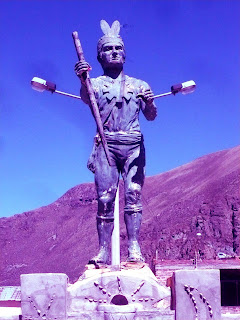It's taken me three months to finally get a blog up and going. Phew!
 |
| Man walking with his sheep down a Tuti street. |
It's been a nice experience getting to know Peru. We are living in the second largest city in the country, Arequipa. It's at a fairly high altitude, and has an extremely dry climate. However, we are finally entering into Peruvian spring and I've seen some rain clouds forming around the top of the Misti mountain that overlooks the city, so we may get some rain in the next few months!
 |
| Roadside altar along the highway. |
I spend every other week in the Colca Valley, about a four hour drive from Arequipa. I arrive in the province's capital, Chivay, and then take combi, a van, another 45 minutes or so to the town of Tuti. Below are some views of the town. You'll notice that its surrounded by mountains, and (although you can't see from the images) sits right between the highway and river. Some larger buidlings (like a couple of restaurants and the 'hotel' where I stay) are made of brick; regular houses and stores are made of stone and have either tin or straw roofs.
I am working on installing the town's Culture and Historical Museum. Unfortunately, plans for opening up another adjacent room have fallen through, so the museum will only have one exhibition space. However, I am happy that this museum might serve as the starting point for developing more community based tourist projects.
 |
| Statue in the fountain in the Plaza de Armas, center of Tuti. Still unsure who it represents.... |
During my time in Tuti, I have gotten to know a few of the movers and shakers in town, especially one senora who is not only a restaurant owner and judge, but also just received an honorary degree from an Arequipa university for her involvement in community projects. It's amazing!
One exhibition idea I had was to collect some of the oral histories from the older residents in the town. I have spoken with two, and after some trial and error, found a place in the market in Arequipa to transfer my tape recordings (that's right, on tiny casette tapes!) onto CD, and then edit the audio with Sony Forge. I've never worked with any program like this before, but I love the challenge of working in a completely new field.
View of Tuti from the street leading to the highway. Far ahead you can see the mountain Pumunuta, where the qolcas (ancient storage bins of corn, etc.) are located. |
 |
| Cow-crossing sign, across the highway from the entrance to Tuti! Funniest thing I've seen in awhile. |
I think that is one of the best aspects thus far of this project. Since the space and the town are so small, I have had to be involved with as much practical work (re-painting, finding translators and printers, etc.) as research aspects (developing a timeline of the local history, working with archaeologists on educational texts, etc.).
 |
| View of Tuti from the highway. You can see the school below (with the terracotta roofs, new), the church of Santisima Cruz (Sacred Cross) in the background. |
Life between the two cities is very different. Arequipa is all city. There are taxis constantly passing, restaurants (including some American, like Pizza Hut and Burger King), and a movie theater. In contrast, Tuti has irregular cell phone service, no cable (the residents pay for downloaded cable on USB, and then plug the USB into a box connected to their television), and vans pass through the town up until about 5pm. After that, you generally have to stay in town for the night.
More pictures and more details are soon to follow!
 |
| The caves of Pumunuta, where the qolcas are. |


No hay comentarios:
Publicar un comentario